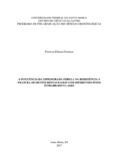| dc.creator | Fontana, Patrícia Eliana | |
| dc.date.accessioned | 2018-06-27T15:21:02Z | |
| dc.date.available | 2018-06-27T15:21:02Z | |
| dc.date.issued | 2017-06-28 | |
| dc.identifier.uri | http://repositorio.ufsm.br/handle/1/13576 | |
| dc.description.abstract | The maintenance of the remaining coronary structure is fundamental for the prognosis of restorative treatment, and the ferrule effect is an extremely important factor, which influences the clinical outcome of teeth with endodontic treatment. The impact of ferrule thickness on fracture resistance of endodontically treated teeth remains controversial, as there are no studies to date. The objective of this study was to investigate the influence of ferrule thickness on fracture resistance after mechanical cycling and failure pattern of teeth restored with different intraradicular posts subjected to the fracture load test. One hundred and twenty bovine incisor teeth were randomized into six study groups, based on the intraradicular post used (fiber post or cast post and core) and the presence and thickness of the ferrule (without ferrule, presence of 0.5 mm or 1 mm thick ferrule, keeping unaltered 2 mm in ferrule height). Full metal crowns and the root posts were adhesively cemented. The samples were subjected to mechanical cycling (37°C, 45°, 130 N, 2.2 Hz, and 2 x 106 pulses). Afterwards, they were subjected to the fracture load test at a speed of 0.5 mm/min and a 45° slope until failure occurred. The failures were classified as favorable and unfavorable. The fracture resistance data were analyzed with 2-factor ANOVA and Tukey's test. The Mann-Whitney test and Chi-square test were used to analyze the pattern of failure. Of all the specimens, 96.7% survived the mechanical cycling. The group with cast post and core and 1 mm ferrule thickness (CPC1) presented a greater resistance to fracture that the group with cast post and core but without ferrule (CPC, p=0.001). Furthermore, varying ferrule thickness were associated with different failure patterns. Thus, ferrule thickness should be considered when choosing different intraradicular posts, looking for the less occurrence of unfavorable failures. | eng |
| dc.language | por | por |
| dc.publisher | Universidade Federal de Santa Maria | por |
| dc.rights | Attribution-NonCommercial-NoDerivatives 4.0 International | * |
| dc.rights.uri | http://creativecommons.org/licenses/by-nc-nd/4.0/ | * |
| dc.subject | Efeito férula | por |
| dc.subject | Núcleo metálico fundido | por |
| dc.subject | Pino de fibra de vidro | por |
| dc.subject | Cast post and core | eng |
| dc.subject | Ferrule effect | eng |
| dc.subject | Glass fiber post | eng |
| dc.title | A influência da espessura da férula na resistência à fratura de dentes restaurados com diferentes pinos intrarradiculares | por |
| dc.title.alternative | The influence of ferrule thickness on resistance to fracture of restored teeth with different intracanal posts | eng |
| dc.type | Dissertação | por |
| dc.description.resumo | A manutenção da estrutura coronária remanescente é fundamental para o prognóstico do tratamento restaurador, e o efeito férula é um fator de extrema importância, o qual influencia o resultado clínico de dentes com tratamento endodôntico. O impacto da espessura da férula na resistência à fratura dos dentes tratados endodonticamente segue controverso, visto que não há estudos até o momento. O objetivo deste estudo foi investigar a influência da espessura da férula na resistência à fratura após ciclagem mecânica, e o padrão de falha de dentes tratados com diferentes pinos intracanais submetidos ao teste de resistência à fratura. Cento e vinte dentes incisivos bovinos foram randomizados em seis grupos, baseados no pino intrarradicular utilizado (pino de fibra de vidro ou núcleo metálico fundido), e na presença e espessura da férula (sem férula, presença de uma férula de 0,5 mm de espessura, e de 1 mm de espessura, permanecendo inalterada uma altura de 2 mm). As coroas metálicas e os pinos intrarradiculares foram cimentados adesivamente. As amostras foram submetidas à ciclagem mecânica (37°C, 45°, 130 N, 2.2 Hz, e 2 x 106 pulsos). Após, elas foram submetidas ao teste de resistência à fratura numa velocidade de 0,5 mm\min, e a uma inclinação de 45º, até que a falha ocorresse. As falhas foram classificadas em favoráveis ou desfavoráveis. Os dados da resistência à fratura foram analisados com os testes ANOVA 2-fatores e Tukey. O teste de Mann-Whitney e o teste Qui-Quadrado foram usados para analisar o padrão de falha. De todos os espécimes, 96,7% sobreviveram à ciclagem mecânica. O grupo restaurado com núcleo metálico fundido e com uma férula de 1 mm de espessura (CPC1) apresentou uma maior resistência à fratura do que o grupo restaurado com núcleo metálico fundido sem férula (CPC, p=0.001). Além disso, a variação na espessura da férula esteve associada com diferentes padrões de falha. Assim, a espessura da férula deve ser considerada ao escolher diferentes pinos intrarradiculares, buscando uma menor ocorrência de falhas desfavoráveis. | por |
| dc.contributor.advisor1 | Kaizer, Osvaldo Bazzan | |
| dc.contributor.advisor1Lattes | http://lattes.cnpq.br/0296170463642286 | por |
| dc.contributor.referee1 | Skupien, Jovito Adiel | |
| dc.contributor.referee1Lattes | http://lattes.cnpq.br/1391921073345927 | por |
| dc.contributor.referee2 | Pereira, Gabriel Kalil Rocha | |
| dc.contributor.referee2Lattes | http://lattes.cnpq.br/9359419479985637 | por |
| dc.creator.Lattes | http://lattes.cnpq.br/7893740875840202 | por |
| dc.publisher.country | Brasil | por |
| dc.publisher.department | Odontologia | por |
| dc.publisher.initials | UFSM | por |
| dc.publisher.program | Programa de Pós-Graduação em Ciências Odontológicas | por |
| dc.subject.cnpq | CNPQ::CIENCIAS DA SAUDE::ODONTOLOGIA | por |
| dc.publisher.unidade | Centro de Ciências da Saúde | por |



